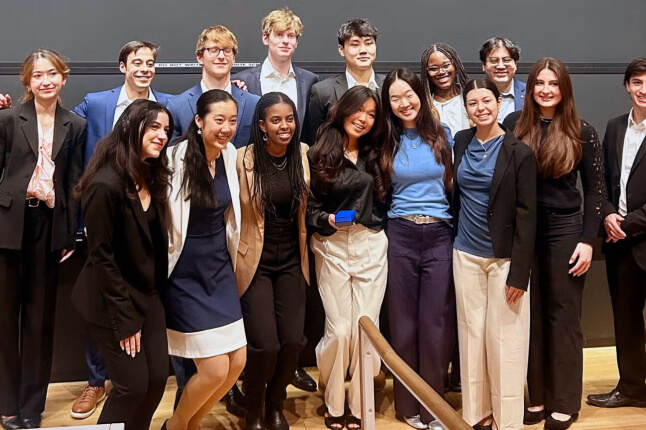News
For their master's capstone project, Yuhan Yao and Luis Henrique Simplício Ribeiro used generative artificial intelligence to analyze the collection of fashion designer Gianfranco Ferré and create designs that resemble his style. (Brittany Buzzutto/SEAS)
Data science and computational science and engineering master’s students at the Harvard John A. Paulson School of Engineering and Applied Sciences (SEAS) take “AC297R: Computational Science and Engineering Capstone Project.” Taught by Weiwei Pan, Assistant Director for Graduate Studies in Data Science, the course groups students together for semester-long research projects in which they work with “client” organizations to tackle real-world challenges.
AI for Fashion
Yuhan Yao (S.M. ‘24), Luis Henrique Simplício Ribeiro (S.M. ‘24), Lorenzo Campana (Politecnico di Milano) and Vittoria Corvetti (Politecnico di Milano)
Client: Gianfranco Ferré Research Center, Politecnico di Milano
What real-world challenge does this project address?
Our project employs data science and AI techniques to explore, manage, preserve, analyze, enrich, and augment a part of fashion designer Gianfranco Ferré’s archival database to demonstrate the possibilities of human-AI co-creation during the creative development phase and bridge fashion cultural heritage with innovative design approaches.
How does this research attempt to solve that real-world challenge?
With access to the digital archive, we explored the use of generative AI tools, such as Stable Diffusion and ChatGPT-4, to generate images based on natural language prompts that resemble the imaginative designs of Gianfranco Ferré’s style.
How did you apply the skills you learned at SEAS to your project?
Data science concepts such as generative models and cloud deployment were crucial parts of the tech stack in our capstone project, both of which were learned in other classes at SEAS.
What part of the project proved the most challenging?
As technical people, learning about fashion as a whole and fashion vocabulary in Italian and French turned out to be the most challenging. The dataset we had access to has a lot of missing data, therefore, we had to come up with creative solutions to handle it.
What part of the project did you enjoy the most?
It is really exciting to see the final result of your effort. I was directly involved in training Stable Diffusion to generate images from textual descriptions, so it was really amazing to actually see the model generating new designs from what it had learned from the archive.
What did you learn, or skills did you gain, through this project?
Besides the technical skills mentioned above, we learned about cross-cultural communication and virtual teamwork. We also learned a lot about generative AI with this project, both text-to-image generative models, and large language models.
Topics: Academics, AI / Machine Learning, Applied Computation, Computer Science, Design
Cutting-edge science delivered direct to your inbox.
Join the Harvard SEAS mailing list.
Press Contact
Matt Goisman | mgoisman@g.harvard.edu


